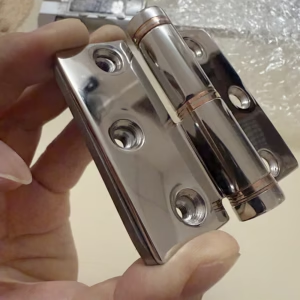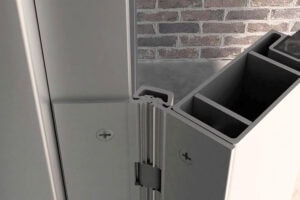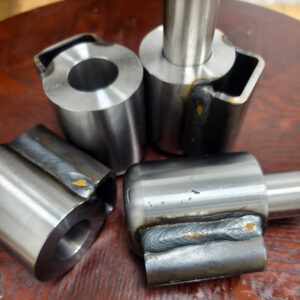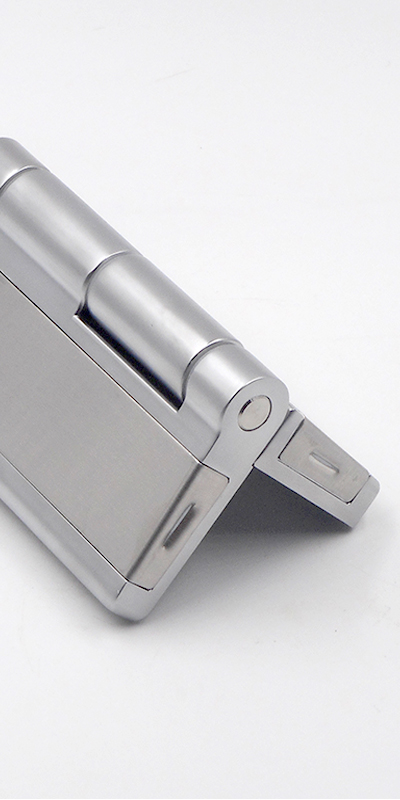Choosing the right hinge shaft material is crucial for ensuring long-term performance and reliability in industrial environments.
304 stainless steel is recommended for industrial hinge shafts because it offers a superior balance of corrosion resistance, durability, and strength. It outperforms iron in moist, chemical, and outdoor environments, and is more economical than 316 stainless while still meeting most industrial performance standards.
Let’s explore why 304 stainless steel is often the smartest choice for hinge shafts in industrial manufacturing environments.

What Role Does the Hinge Shaft Play in Industrial Equipment?
The hinge shaft, also known as the hinge pin, is the central rotating axis of any hinge system. It connects two hinge leaves and allows movement between them, ensuring proper door or panel function in industrial enclosures. The hinge shaft connects and rotates the hinge leaves, bearing mechanical loads and ensuring structural integrity during frequent door operations.
In an industrial setting, where doors are often large, heavy, and operated frequently, the shaft is exposed to constant motion, high loads, and varying environmental factors. It must support the weight of the door or panel, manage the torque during opening and closing, and maintain alignment over thousands of cycles.
Heavy-duty applications, such as electrical enclosures or access panels in manufacturing equipment, often require enhanced shaft strength. Components like Heavy Duty Continuous Hinges or Weld-on hinges in industrial applications rely heavily on robust shafts to prevent mechanical failure.
Why Is Shaft Material So Critical in Industrial Applications?
Material choice directly impacts the shaft’s ability to withstand industrial stressors such as corrosion, vibration, high load, and extreme temperatures. Material choice affects the hinge’s ability to resist fatigue, corrosion, and deformation under repeated industrial usage.
If an unsuitable material is used—such as raw iron or low-grade steel—the shaft may rust, bend, or fracture over time, especially in environments where moisture, chemicals, or high usage are factors. These issues lead to premature hinge failure, causing misaligned doors, safety hazards, and costly downtime for repairs or replacements.
In contrast, a properly selected shaft material like 304 stainless steel ensures optimal performance in high-cycle, harsh conditions. For example, manufacturers using Adjustable friction hinges in test chambers or environmental simulation equipment need shaft materials that can handle continuous torque and environmental exposure.

What Makes 304 Stainless Steel Ideal for Industrial Hinge Shafts?
304 stainless steel is a chromium-nickel alloy known for its corrosion resistance, strength, and formability—making it a top choice for hinge pins in industrial products. 304 stainless steel offers excellent corrosion resistance, strength, and weldability—making it ideal for industrial hinges used in harsh environments.
Its non-magnetic nature and resistance to oxidation make it particularly valuable in humid, outdoor, and chemical-rich environments. The metal can be easily welded and fabricated, making it suitable for complex or customized hinge designs.
In real-world applications such as marine equipment, electrical enclosures, and constant-humidity test chambers, 304 stainless steel maintains structural integrity where other materials fail. It supports torque mechanisms and retains functionality over thousands of opening and closing cycles.
Compared to carbon steel or iron, 304 stainless maintains its surface finish, preventing contamination in cleanroom or hygienic equipment. And while 316 stainless has slightly higher resistance, especially to chlorides, its higher cost makes 304 a more efficient solution in most cases. Wide-throw hinges, often used on heavy industrial doors, greatly benefit from the shaft strength of 304 stainless steel.
How Does 304 Compare to Iron and 316 Stainless Steel?
Each material has its own properties, and choosing the right one depends on the environmental exposure and functional requirements of the hinge. 304 stainless steel provides better corrosion resistance than iron and is more cost-effective than 316, making it the balanced choice for most industrial needs.
| Property | Iron Shaft | 304 Stainless Steel | 316 Stainless Steel |
|---|---|---|---|
| Corrosion Resistance | Low | High | Superior (Marine Grade) |
| Load Capacity | Moderate | High | High |
| Weldability | Moderate | Excellent | Excellent |
| Cost | Low | Medium | High |
| Industrial Suitability | Indoor Only | Outdoor & Indoor | Harshest Environments |
Iron shafts are prone to rust, especially in high-humidity or coastal environments. While 316 stainless steel offers better corrosion resistance—particularly against saltwater—its cost is often unjustified unless used in marine or chemical applications.
304 is the ideal middle ground, offering excellent resistance to corrosion and wear, while remaining affordable and highly workable. Products like Heavy Duty Detachable Barrel Hinge often utilize 304 shafts to balance strength and corrosion resistance without inflating costs.

When Should You Use 304 Stainless Steel Instead of Other Materials?
Understanding when 304 stainless is necessary versus when iron or 316 is acceptable helps engineers and buyers optimize both performance and cost.
Use 304 stainless steel for hinge shafts exposed to moisture, load stress, vibration, or chemicals—common in industrial and outdoor settings.
Recommended Use Cases:
-
Outdoor electrical control boxes
-
Climate test chambers
-
Marine or coastal industrial equipment
-
High-cycle machine doors
-
Pharmaceutical or food production systems
In these environments, iron would fail quickly due to rust and fatigue. On the other hand, 316 may be over-specified unless in continuous saltwater contact or chemical exposure. 304 remains the optimal choice for these mid-to-high-demand scenarios.
When Iron Might Suffice:
Iron shafts can still be a viable choice in low-stress indoor applications such as secondary electrical panels or maintenance closets. These require minimal exposure to environmental hazards and don’t undergo high use cycles.
But for mission-critical equipment, or for buyers looking to Replace Industrial Door Hinges, it’s wise to consider the total cost of ownership—where 304’s durability pays off over time.
Conclusion
304 stainless steel hinge shafts offer a proven combination of corrosion resistance, strength, and weldability. For most industrial applications, they provide long-term value, reduce maintenance needs, and ensure equipment integrity in demanding environments.




